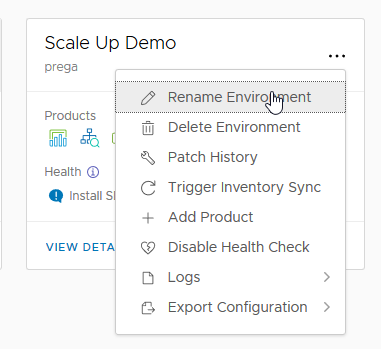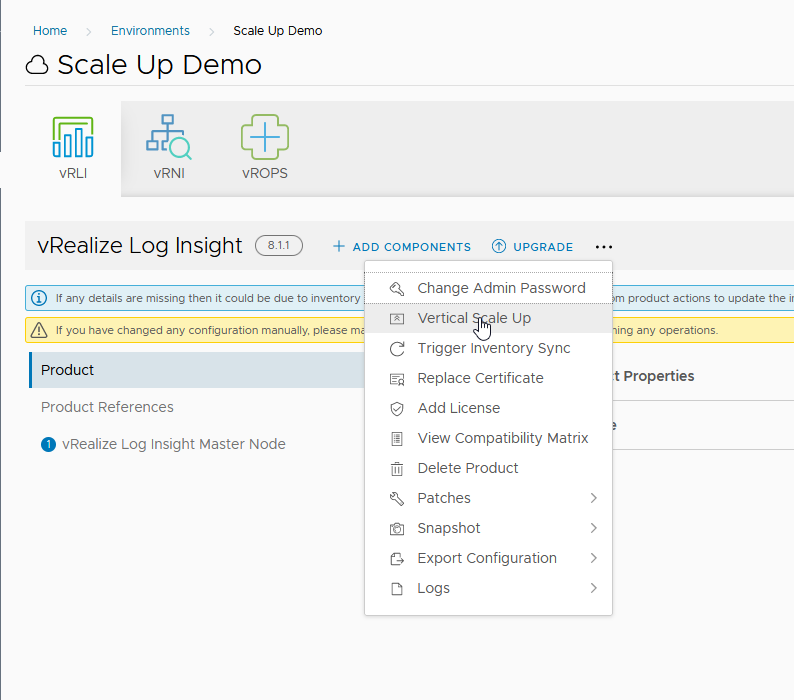Our product team has been hard at work delivering new features and updates that you, our customers, have asked for in vRealize Suite Lifecycle Manager. In this blog, I will cover what’s new in the latest release, 8.2, which is now available for download.
Here’s an overview of what’s new:
- Support for VMware Cloud Foundation and VMware Cloud on AWS
- vRealize Network Insight data source lifecycle management
- Scale up and vRealize Operations continuous availability support
- Fixing mistakes of the past
- Part of the new vRealize Cloud Universal
- Updates to the platform
Support for VMware Cloud Foundation and VMware Cloud on AWS
The main pillar of vRealize Suite Lifecycle Manager (vRSLCM) is, of course, the Lifecycle Operations service which allows you to create new vRealize environments, deploy and manage them and even patch and upgrade the products as new releases become available. Naturally, many of the updates fall under this service.
First, I want to point out that vRSLCM doesn’t exist in a bubble – it plays nicely with our core cloud offerings, VMware Cloud Foundation (VCF) and VMware Cloud on AWS.
Previously we had awesome integration with VCF’s SDDC Manager, with the ability to deploy Lifecycle Manager directly from SDDC Manager. Things got, well, awesome-er with VCF 4.1 and vRSLCM 8.1.1 (note that is the version shipping with VCF, 8.2 will be supported in an upcoming release of VCF).

Now vRSLCM is deployed in a “VCF Aware” mode, providing bi-directional communications so that SDDC Manager understands which vRealize Suite products have been deployed. It can also handle things like binary downloads and patching directly from the SDDC Manager UI to simplify operations. In addition, SDDC Manager will automatically deploy an NSX-T load balancer for the vRealize environment, so that’s one less thing to worry about. Another benefit is that vRSLCM, in VCF Aware mode, will deploy vRealize Suite products according to VMware Validated Design, as well as configuring connectivity between each product and the VCF SDDC.
Many VMware Cloud on AWS customers have asked if it is supported to run vRealize Suite on their SDDCs and the answer is yes. To make that easier, vRSLCM 8.2 now officially supports installing on VMware Cloud on AWS SDDC as well as deployment of vRealize Suite products therein. This is supported for M11 and M12 releases of VMware Cloud on AWS.
vRealize Network Insight Data Source Lifecycle Management
Continuing down the list of Lifecycle Operations enhancements, vRNI configuration gets a big boost with enhancements to configuration and management of data sources.
Now, in addition to adding data sources for vRNI, you can also edit and delete them. Even better, you can bulk load data sources using JSON or CSV files which is very helpful when you have a lot of switches, routers, or other data sources with similar configurations. Similarly, passwords for data sources can now be managed in bulk, allowing for a single operation to update passwords across all of your network components, for example.

For networking gear, it is common to use SNMP for data sources. In vRSLCM 8.2 you can now create SNMP configurations for use in vRNI data sources for switches, routers and other networking endpoints.
New Scale Up and vRealize Operations CA Support
Since the 8.0 release, vRealize Operations has had a “Continuous Availability” (CA) feature which allows for splitting your clusters into two fault domains, using a witness node to help arbitrate failures and availability.
In vRSLCM 8.2 you now have the option to deploy a new vRealize Operations cluster with CA enabled. This will not only allow you to configure the fault domains and witness node, but the pre-check will let you know if the configuration doesn’t meet best practices for vRealize Operations CA.

Often, customers will find that the initial sizing for a product deployment was too low and usage has increased to the point that it is time to add more capacity. vRSLCM has always supported the ability to add nodes to product clusters for “scale out”, but now we have added support for “scale up” allowing you to increase the size of cluster nodes. Supported sizes for CPU and RAM are selectable and optionally you can also extend disk capacity. All nodes are uniformly configured as well. You can use the Vertical Scale Up action on your vRealize Log Insight, vRealize Network Insight and vRealize Operations deployments.
Fixing Mistakes of the Past
So, the person you took over for left you with an environment named “Computer McComputerFace” and you’ve had to look at that stupid environment name for months. Good news for you because in vRSLCM 8.2 you can now rename your data centers and environments. So good-bye “Computer McComputerFace” and hello “London Production” environment… much better!

Also supported now is the ability to delete vCenters.
Speaking of fixing mistakes, or just doing cleanup, you can now edit and delete Locker passwords in vRSLCM 8.2. The passwords will now let you see references, or where they are being used. Of course, if they are in use, you won’t be able to change or delete them, but at least you know where they are being used.
Updates to the Platform
If you are like me, you really love REST APIs, the ability to programmatically control and leverage a solution in creative ways that make your life easier. And if you are also like me, the most exciting announcement with vRSLCM 8.2 is the release of supported and documented public APIs. Documented using the Swagger framework, there are some handy APIs for Lifecycle Operations and Locker services. And the documentation is easy to find, just click the API link on the user menu. Additionally, Anuradha Krishna, Engineering Manager for vRSLCM, has shared a Postman collection for these APIs to help customers get started – check it out here. How will you use these APIs? Let me know in the comments!
Another helpful addition is the ability to replace certificates for vRSLCM. In the Lifecycle Operations system menu you will find a new card which allows you to replace the self-signed certificate with your own custom certificate.
Finally, customers who have requirements to meet the Federal Information Processing Standard (FIPS) will be happy to know that vRSLCM is now FIPS 140-2 compliant by default. You can optionally disable FIPS compliance mode, if needed. This will require a reboot of the vRSLCM appliance.
Upgrade Today
A lot of great updates, thanks to our product team. If you are a vRealize Suite customer and you are not using vRealize Suite Lifecycle Manager this is a great time to get started. You can import your existing product installations and take advantage of patching, upgrades, scale up/out, content management and much more. If you are not a vRealize Suite customer, go to our web page and learn why vRealize Cloud Management helps you “Make Cloud Your Business.”
For a limited time, VMware is inviting organizations to take advantage of a promotional offer of 50% off vRealize Suite and vCloud Suite Standard so you can start optimizing your private or hybrid cloud environments, now.








